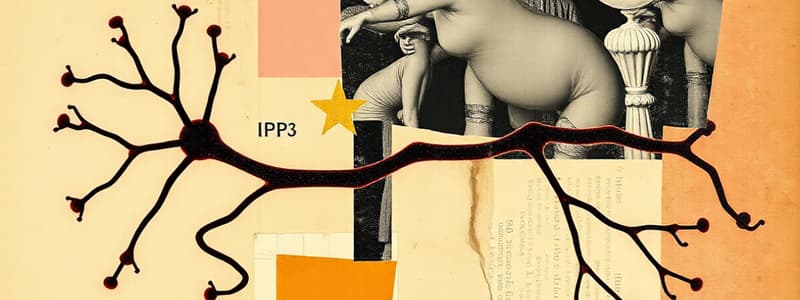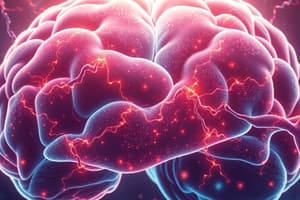Podcast
Questions and Answers
A novel drug selectively activates phospholipase C in cells. Which downstream effect is least likely to occur as a direct consequence of this drug's action?
A novel drug selectively activates phospholipase C in cells. Which downstream effect is least likely to occur as a direct consequence of this drug's action?
- Inhibition of myosin light chain kinase (MLCK). (correct)
- Increased intracellular calcium concentrations.
- Activation of protein kinase C.
- Cleavage of phosphatidylinositol bisphosphate (PIP2).
A researcher is studying a newly discovered compound that inhibits adenylyl cyclase. Which of the following outcomes would be least expected in cells treated with this compound?
A researcher is studying a newly discovered compound that inhibits adenylyl cyclase. Which of the following outcomes would be least expected in cells treated with this compound?
- Enhanced glycogenolysis in the liver. (correct)
- Decreased cardiac muscle contractility.
- Reduced activation of protein kinase A.
- Decreased levels of cAMP.
A patient is administered a medication that selectively stimulates alpha 2 receptors. Which of the following physiological responses is the most likely outcome?
A patient is administered a medication that selectively stimulates alpha 2 receptors. Which of the following physiological responses is the most likely outcome?
- Increased heart rate and force of contraction.
- Bronchodilation in the lungs.
- Increased lipolysis in adipose tissue.
- Inhibition of norepinephrine release from presynaptic neurons. (correct)
Which of the following scenarios would least likely be associated with activation of beta 2 receptors?
Which of the following scenarios would least likely be associated with activation of beta 2 receptors?
A drug is developed to selectively target Gq proteins. Which of the following downstream effects would be most directly influenced by this drug?
A drug is developed to selectively target Gq proteins. Which of the following downstream effects would be most directly influenced by this drug?
A researcher discovers a new receptor that, when activated, leads to a decrease in intracellular calcium levels in neurons. Which G protein type is most likely coupled to this receptor?
A researcher discovers a new receptor that, when activated, leads to a decrease in intracellular calcium levels in neurons. Which G protein type is most likely coupled to this receptor?
A patient presents with symptoms of anaphylactic shock following a bee sting. Epinephrine is administered. By what mechanism does epinephrine primarily alleviate the patient's symptoms?
A patient presents with symptoms of anaphylactic shock following a bee sting. Epinephrine is administered. By what mechanism does epinephrine primarily alleviate the patient's symptoms?
A scientist is investigating the effects of a novel compound on smooth muscle contraction. The compound increases intracellular cAMP levels. Which of the following outcomes is most likely?
A scientist is investigating the effects of a novel compound on smooth muscle contraction. The compound increases intracellular cAMP levels. Which of the following outcomes is most likely?
A researcher is studying the effects of a drug on liver cells. The drug increases glycogenolysis. Which receptor type is most likely activated by this drug in the liver?
A researcher is studying the effects of a drug on liver cells. The drug increases glycogenolysis. Which receptor type is most likely activated by this drug in the liver?
A new drug selectively blocks beta 3 receptors. Which of the following effects would be most expected?
A new drug selectively blocks beta 3 receptors. Which of the following effects would be most expected?
Following a lab error, a researcher accidentally administers a high dose of a non-selective beta-adrenergic agonist to a mouse. Which combination of physiological effects would be most likely to occur?
Following a lab error, a researcher accidentally administers a high dose of a non-selective beta-adrenergic agonist to a mouse. Which combination of physiological effects would be most likely to occur?
A patient is prescribed clonidine to manage hypertension. What is the primary mechanism by which clonidine lowers blood pressure?
A patient is prescribed clonidine to manage hypertension. What is the primary mechanism by which clonidine lowers blood pressure?
A drug inhibits the function of Gs proteins. Which physiological response would be least likely to be affected by this drug?
A drug inhibits the function of Gs proteins. Which physiological response would be least likely to be affected by this drug?
A researcher aims to develop a drug that selectively increases insulin secretion. Targeting which of the following receptors or mechanisms would be least effective?
A researcher aims to develop a drug that selectively increases insulin secretion. Targeting which of the following receptors or mechanisms would be least effective?
Which of the following best describes the functional relationship between alpha 2 and beta 2 receptors, as described in the content?
Which of the following best describes the functional relationship between alpha 2 and beta 2 receptors, as described in the content?
Flashcards
Adrenergic Receptors
Adrenergic Receptors
Classified into alpha (α) and beta (β) types, which are further divided into subtypes.
G Protein Coupling
G Protein Coupling
Alpha 1 (α1): Gq proteins. Alpha 2 (α2): Gi proteins. Beta (β) receptors: Gs proteins.
Second Messenger Effects
Second Messenger Effects
α1: Increase IP3 and DAG (excitation). α2: Decrease cAMP (inhibition). β: Increase cAMP (variable effects).
Alpha 1 Mechanism
Alpha 1 Mechanism
Signup and view all the flashcards
Beta Receptor Mechanism
Beta Receptor Mechanism
Signup and view all the flashcards
Alpha 2 Function
Alpha 2 Function
Signup and view all the flashcards
Alpha 1 Actions
Alpha 1 Actions
Signup and view all the flashcards
Alpha 2 Actions
Alpha 2 Actions
Signup and view all the flashcards
Beta 1 Actions
Beta 1 Actions
Signup and view all the flashcards
Beta 2 Actions
Beta 2 Actions
Signup and view all the flashcards
Beta 3 Actions
Beta 3 Actions
Signup and view all the flashcards
Beta 1 Effect on Heart
Beta 1 Effect on Heart
Signup and view all the flashcards
Alpha 2: Neurotransmitter Release
Alpha 2: Neurotransmitter Release
Signup and view all the flashcards
Alpha 1 locations
Alpha 1 locations
Signup and view all the flashcards
Beta 2: Vascular Smooth Muscle
Beta 2: Vascular Smooth Muscle
Signup and view all the flashcards
Study Notes
Adrenergic Receptors
- Adrenergic receptors are classified into alpha and beta receptors
- Alpha receptors are further classified into alpha 1 and alpha 2 receptors
- Beta receptors are further classified into beta 1, beta 2, and beta 3 receptors
- All adrenergic receptors are G protein-coupled receptors
G Protein Types
- Alpha 1 receptors are coupled with Gq proteins
- Alpha 2 receptors are coupled with Gi proteins
- Beta 1, Beta 2, and Beta 3 receptors are coupled with Gs proteins
Second Messengers
- Alpha 1 receptors elevate inositol triphosphate (IP3) and diacylglycerol (DAG) levels
- This leads to increased intracellular calcium levels and excitation
- Alpha 2 receptors decrease cyclic AMP (cAMP) levels
- This leads to inhibition
- Beta 1, Beta 2, and Beta 3 receptors increase cAMP levels
- This can produce contraction or relaxation based on the target organ
- IP3 and DAG always increase intracellular calcium levels
- This results in excitation of the postsynaptic membrane
- In muscles this causes contraction
- In neurons this causes excitation
- In glands, this causes secretion
- cAMP roles vary based on target organ
- In the heart, elevated cAMP increases the rate and force of contraction
- In smooth muscle, elevated cAMP produces relaxation
- Decreased cAMP levels result in inhibited response
Alpha 1 Receptor Mechanism
- Norepinephrine binds to alpha 1 receptors
- Activation of phospholipase C occurs
- Phospholipase C cleaves phosphatidylinositol bisphosphate (PIP2) into IP3 and DAG
- DAG activates protein kinase C
- Protein kinase C opens inward-going calcium channels
- Calcium enters through calcium channels, and IP3 releases calcium from internal stores
- Increased intracellular calcium produces contraction in smooth muscle, excitation in neurons, or secretion in glands
- Alpha 1 receptors are excitatory and increase intracellular calcium levels
Beta Receptor Mechanism
- Norepinephrine binds to beta receptors
- Activation of G alpha s (Gs) subunit occurs
- This activates adenylyl cyclase
- Adenylyl cyclase converts ATP into cAMP
- Elevated cAMP levels produce variable effects based on the target organ
- In the heart, cAMP activates protein kinase A, increasing intracellular calcium levels
- Calcium binds with troponin, leading to cardiac muscle contraction
- In smooth muscle, cAMP inactivates myosin light chain kinases (MLCK)
- This results in smooth muscle relaxation
- In adipose tissue, cAMP increases lipolysis via protein kinase A
- In the heart, cAMP activates protein kinase A, increasing intracellular calcium levels
Alpha 2 Receptors
- Alpha 2 receptors decrease cAMP levels in neurons
- Results in reduced calcium levels, leading to reduced exocytosis
- Alpha 2 receptors are inhibitory, inhibiting neurotransmitter release
Alpha 1 Receptor Locations and Actions
- Locations include smooth muscle, liver, and salivary glands
- Smooth muscle: Contraction of vascular smooth muscle and other smooth muscles like eye, bladder, prostate, uterus
- Exception: Relaxation of GI smooth muscle
- Alpha 1 receptors on GI smooth muscle are coupled with the opening of potassium channels, producing hyperpolarization
- Exception: Relaxation of GI smooth muscle
- Liver: Increase glycogenolysis (breakdown of glycogen into glucose)
- Salivary glands: Increase saliva secretion
- Smooth muscle: Contraction of vascular smooth muscle and other smooth muscles like eye, bladder, prostate, uterus
Alpha 2 Receptor Locations and Actions
- Located mainly at presynaptic neurons
- Decrease cAMP levels, inhibiting exocytosis
- Decrease norepinephrine and acetylcholine release
- Auto-inhibitory nature
- Located within the CNS as presynaptic neurons
- Decrease central sympathetic discharge
- Clonidine is an alpha 2 agonist that decreases central sympathetic discharge
- Decrease central sympathetic discharge
- Pancreas: Decrease insulin release, increasing glucose levels
- Platelets: Inhibit platelet aggregation
Beta 1 Receptor Locations and Actions
- Located mainly on the heart and kidney, and also on adipose tissue
- Heart: Increase rate and force of contraction (positive chronotropic and ionotropic effects), increasing cardiac output
- Increase automaticity in the cardiac muscle
- Kidney: Increase renin release, leading to vasoconstriction
- Adipose tissue: Increase lipolysis
Beta 2 Receptor Locations and Actions
- Located mainly on smooth muscle
- Vascular smooth muscle: Vasodilation in blood vessels supplying skeletal muscle, liver, and heart
- In other systemic blood vessels, alpha 1 receptors are predominant
- Other smooth muscles: Relaxation of eye, bronchioles, bladder, uterus, and GI smooth muscle
- Vascular smooth muscle: Vasodilation in blood vessels supplying skeletal muscle, liver, and heart
- Liver: Increase glycogenolysis
- Neurons: Increase release of mediators like norepinephrine (auto-stimulatory)
- Beta 2 receptors are auto-stimulatory, opposite of alpha 2 receptors
- Mast cells: Inhibit degranulation, decreasing histamine release
- Epinephrine can be used for anaphylactic shock, acting through beta-2 receptors to inhibit mast cell degranulation
Beta 3 Receptor Locations and Actions
- Located mainly in adipose tissue
- Increase lipolysis (breakdown of triglycerides into free fatty acids)
- Beta 1 receptors are also present on adipose tissue, but beta-3 receptors are more dominant in many fatty tissues
Studying That Suits You
Use AI to generate personalized quizzes and flashcards to suit your learning preferences.




